To live and die for gold: Metals mining returns to El Salvador
A new law ushers in the return of an industry that’s been prohibited since 2017, threatens to send workers back to the absolute control of foreign companies — and, environmentalists warn, comes at a high ecological cost
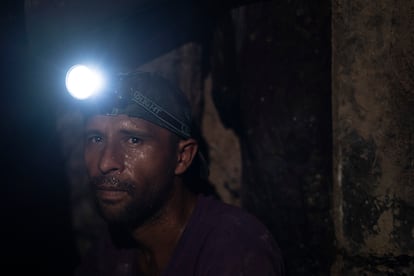
Standing atop a hill, two men look closely at the white stones resting in their hands. They tilt them slightly, allowing the sunlight to glint off of the small golden sparkles that flicker on their surface. “No,” says Melvin, the youngest of the pair, regarding the rocks with disdain. “This isn’t real gold, it’s fool’s gold.” “Yes,” confirms Antonio, with the certainty of one who has spent a lifetime in the mountains. “It’s margaja. But that means there’s gold nearby.”
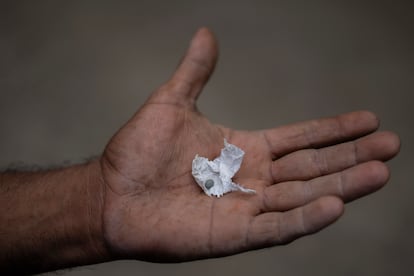
It’s afternoon in mid-January, and before the two men yawns the open mouth of a subterranean mine. We’re on top of the San Sebastián Hill, located at the easternmost point of El Salvador, a few miles from its border with Honduras. Melvin and Antonio have been digging this hill together for more than 20 years, intent on extracting every ounce of gold it hides. The sun begins to set, bathing the mountain range behind them in a golden light. “There’s gold in all of this. It’s just very difficult to extract,” says Melvin.
The gold these men collect from San Sebastián Hill does not come in the form of rocks or nuggets. Their work is more akin to alchemy: they descend into the mines for hours on end searching for small, colored furrows whose sparkle betrays them among the rocks. They use a drill to cut into the stones, which they then grind into a fine powder. They add water, salt, lime and a few drops of mercury, which forms a silvery paste. They strain this mixture several times, using a cloth to separates dirt from denser material, finally molding it into a nugget the size of half their extended palm. They then place the material into a hot comal set atop a flame until its metallic sheen disappears, and what remains is a small sphere that weighs about a gram and is the color of the sun.
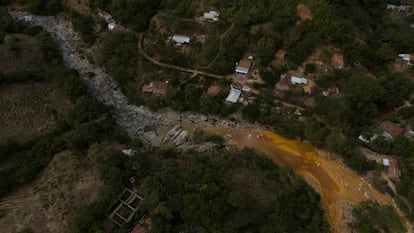
A thousand other güiriseros, as the independent miners are called, inhabit these hills. They form a community that for generations has worked in the mining of metals that, until a few weeks ago, was totally prohibited.
Mining of the San Sebastián Hill began in 1904. For the first 13 years, miners extracted more than 25 tons of gold from it, according to numbers from the National Roundtable on Metal Mining in El Salvador. By 1969, the area was considered the country’s “gem of the mining industry” and was one of the most prolific mines in Central America, according to the United Nations. Between 1969 and 1980, the hill yielded a ton of gold, according to a report from the Hydrocarbons and Mines Regulatory Directorate of the Ministry of Economy.
Over the following decades, mining in San Sebastián was paused due to the Salvadoran civil war. After the 1992 peace agreements, two U.S. companies reactivated production for more than 10 years. In 2006, the Salvadoran government discontinued their permits and the mines were abandoned.
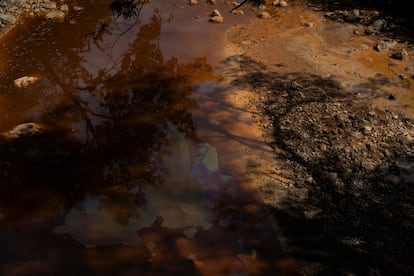
Ferocious extraction of gold left an indelible mark on San Sebastián — and it wasn’t prosperity. Today, its streets are still dirt roads and the majority of its inhabitants, very poor. After nearly 100 years of mining, the hill is full of cyanide, a toxic material the mines used in enormous quantities. A stream flows down the hill like a colossal snake with red and gold scales, exhaling a sulphureous breath that permeates the surrounding air. The San Sebastián River has become an undeniable symbol of the impact of mining-related pollution. Nobody can drink its water and, if a well is dug, its walls will be covered in sediment, its waters infused with a strange smell. Because of this, residents have to buy water from faraway towns, on which they spend 20% of their earnings, according to a study by the Salvadoran public prosecutor’s office. After the departure of the mining companies, the inhabitants of San Sebastián were left unemployed and living on polluted lands. Lacking fertile ground in which to plant and rivers that could supply livestock with drinking water, they set out to exploit the only thing they had left: the gold mines that had been left to oblivion.
Ten years after the mining companies abandoned the hill, in April 2017, the country’s legislature approved a law that categorically prohibited mining. The government promised to find new work for the güiriseros. It didn’t deliver. So the area’s inhabitants continued to dig, even at the risk of further pollution. Now, each family and group of neighbors has its own mine.
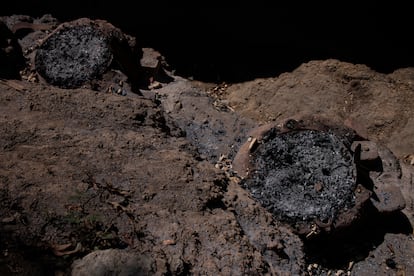
Though the amount of gold that the güiriseros get out of the old mines tends to be minimal and barely covers their cost of living, sometimes the hill proves more generous. A few years ago, Melvin and Antonio recall, a group of 30 miners from a community called Los Indios came across a fortune: a vein of gold that brought them wealth and hope of continuing windfall. Every week, they extracted an amount of gold worth thousands of dollars. They brought their bonanza to the closest town, Santa Rosa de Lima, and rented out entire brothels to celebrate. They built houses and purchased beer, cars and motorbikes, spending non-stop. For six months, fortune smiled on them. But their joy did not last. One by one, the miners came up empty-handed. The vein ran out and with it, their fleeting opulence disappeared. John, one of the group’s members, used to wake up lying in the dirt after nights of excess. He lost his job, and now earns $20 a day as a bricklayer. Sometimes, the hill gives. Sometimes, it takes away.
Nowadays, the inhabitants of San Sebastián have one more thing to worry about: a few weeks ago, President Nayib Bukele announced that industrial metals mining would return to El Salvador and on his orders, the legislature approved a law to permit just that. The San Sebastián güiriseros believe that the hill and its gold will once again become the property of foreign corporations, leaving them empty-handed.
The return of the mining industry is the source of much polemic in El Salvador. On one hand, there are those who make their living from gold. On the other are the environmentalists who are opposed to mining based on the high levels of pollution that it causes. Fighting against the mines is nothing new for the latter group. A few years ago, they staged a historic battle to ban the industry that left four activists dead.
And then there’s the perspective of President Bukele, whose new proposal, in the eyes of many, is as Solomonic as it is misleading. The president has stated that 99% of the rivers in El Salvador are already contaminated. He is proposing the reactivation of “responsible” mining which, though it will further contaminate the waterways, he claims will provide enough funds to then clean them up.
Dying for gold
Marlon, a 16-year-old, grinds a small stone into a fine powder which he puts into a cow horn that’s been split in half. He adds water, stirs it with his fingers and stares at the liquid as it slowly clears, until a white grit remains at the bottom. Delicately, he rocks the horn. “See, there it is. Yes, there’s gold,” he says with a joyful smile.
This procedure, which is referred to as the tiento, is a test used by güiriseros to detect the presence of gold. The glint visible in the rocks is not the precious metal, but rather another mineral known as margaja or fool’s gold. When the mix settles and leaves a light golden crust, the miners know they’ve found something of value. And they prepare to enter the depths of the hill.
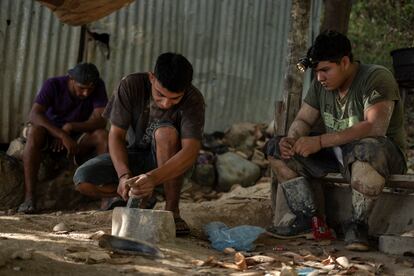
Mining is more than a profession here; it is heritage. Melvin, for example, is a miner just like his father before him, and now, his son. In San Sebastián, every family has a mill and the necessary tools to extract gold. But the activity is risky. Within the mine the heat is suffocating and oxygen is scarce. A compressor pushes oxygen down to its depths. If it fails, miners have less than 20 minutes to get out before they suffocate to death. And then there are the cave-ins. “It has happened in other mines. In this one, thank God, it hasn’t,” says Melvin. Still, danger lurks above ground as well. To extract gold, the güiriseros employ mercury, a poison that contaminates the blood of those who come into contact with it, although the miners of San Sebastián deny that such risks exist.
A report that was carried out by Salvadoran Office of the Human Rights Ombudsman in 2016 found that the water of the San Sebastián River and other tributaries are contaminated with high levels of aluminum, zinc, iron, manganese, nickel and arsenic. Those who are most vulnerable to this pollution are the women who wash clothes in the river and who, according to the report, suffer from headaches, fatigue and memory problems. The miners acknowledge some of these symptoms, but say they are not caused by mining. However, not everyone in San Sebastián is prepared to accept this pollution as inevitable. For years, there has been a group of residents who resist mining.
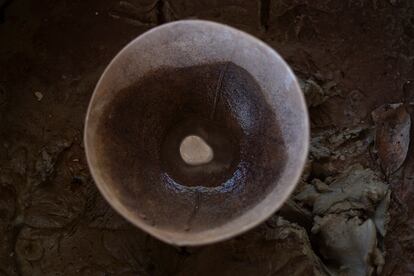
Vidalina Morales uses her hands to brush away the dry leaves that cover the tomb of Marcelo Rivera, moving a bouquet of artificial flowers to read his epitaph: “Unbreakable defender of the environment.” Rivera disappeared on June 18, 2009. His tortured corpse was found 12 days later at the bottom of a well. Since then, the community of Santa Marta, in the department of Cabañas, has remembered him as the first environmental martyr in El Salvador. They say he was assassinated as part of a terror campaign against environmentalists that was carried out after complaints were made against the mining companies Pacific Rim/Oceana Gold. In the years that followed, another three activists met the same fate.
The Salvadoran Public Prosecutor’s Office accused criminal organizations of being responsible for Rivera’s death. However, the community of Santa Marta claims that investigation of the case was insufficient and that authorities never attempted to find the people who ordered the killing.
Resistance against mining in El Salvador began in 2004, when Santa Marta organized to block the construction of an open-air garbage dump. At that point, an authority from the Ministry of Environment told activists that the dump was the least of their problems; the next step was metals mining.
Historically, Cabañas has been the site of gold mining. The activity dates back to the start of Spanish colonialism and one of its primary towns was named San Francisco El Dorado (The Golden One) due to the abundance of the metal. Halfway through the last century, the Oceana Gold mining company bought a property it named Mina El Dorado, which shut down in 1953 and was subsequently abandoned.
In light of this history, the residents of Santa Marta and its neighboring communities didn’t initially realize what was implied by the reactivation of mining. Researching this became their first act of resistance. They traveled to Hondurus and saw poisoned rivers and devastated forests. They came home fearful, but resolute.
Upon their return, they found out that Pacific Rim had been charting the area for years, digging into hills and extracting water from its rivers. To win over the community, the company financed the reconstruction of streets, schools, medical facilities and even hosted children’s events, complete with piñatas. Meanwhile, the residents of Santa Marta got organized, traveling to neighboring communities with an old television and presentations on blankets that they hung up to explain what mining entailed. When Pacific Rim found itself unable to win over the populace with gifts, the company resorted to threats. And then came the murders.
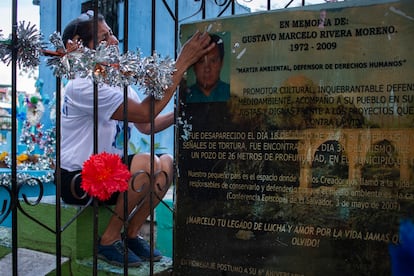
In 2017, after years of protests, their resistance achieved a historic feat: El Salvador became the first country in the world to prohibit metals mining. Environmentalists thought they’d won. But in January 2023, something changed. Five San Marta activists were arrested and accused of crimes they’d supposedly committed during the civil war. Antonio Pacheco, Miguel Gómez, Alejandro and Pedro Laínez and Saúl Rivas spent 22 months in prison. The reasoning behind their detention seemed to be politically motivated, and Morales and her peers were sure that it had to do do with their opposition to mining.
The environmentalists were set free in November due to lack of evidence, but the Bukele-controlled Public Prosecutor’s Office appealed the judge’s decision. Their case was to be reviewed on Wednesday, but the five defendants decided not to show up in court, alleging they no longer trusted the Salvadoran justice system.
In December, a single post on X by Bukele threw more than a decade of struggle by anti-mining communities in the dustbin: “We are the ONLY country in the world with total prohibition of metals mining. Absurd!” Just one week later, on the day before Christmas Eve, his legislature approved a new law that allowed for the return of the mining industry.
Bukele’s reasoning for this directive has been sparse. In first place, he says that gold is an enormous treasure that God himself has placed in the country’s hands. Secondly, that in just 4% of El Salvador there are 50 million ounces of gold and that in the entire country, there is approximately $3 billion worth of the mineral. A report from the Heinrich Böll Foundation appears to contradict these assertions. According to that document, if this data were true, El Salvador would be home to a quantity of gold equal to 60% of the total amount that has been extracted from the planet throughout history.
The Salvadoran Catholic church has joined the fight, and in recent weeks, has asked parishioners to sign a petition against mining. “So much effort to stop mining by the world’s largest owners of gold. But they never spoke out when 30 Salvadorans were killed every day. On the contrary, they endorsed and gave their ‘blessing’ to negotiate with them,” the president wrote in reference to the church.
The green metals mining promised by the government is a euphemism to describe a “more responsible” polluting industry. For that to be real, according to experts, companies would have to comply with conditions like strict legal framework and a powerful state that forces them to operate within regulations, in addition to using advanced, low-emission technology. Throughout its history, El Salvador has been more disposed to lax regulation that allows companies to pocket all earnings, leaving behind a polluted country.
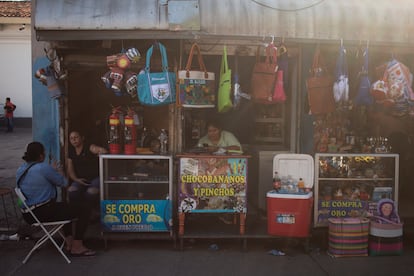
It’s unclear why humankind has assigned such value to gold. Some say it’s due to the mineral’s scarcity and resistance to oxidization. Others, that it has to do with its color, so close to that of the sun. One thing we do know, according to scientists, is that the precious metal originates in space and likely arrived on Earth via meteorite or from the implosion of a star.
Abel, a goldsmith who makes a living buying the mineral that the güiriseros of San Sebastián extract from the hill, says gold’s elevated worth can be attributed to “pure vanity”. “Have you seen that celebrities are covered in gold? People buy gold because they want to look like them,” he says.
This is all of little concern to Melvin the güirisero. To him, gold is simply a valuable object hidden away in the hill. A job that allows him to make some money. Thanks to it, he has built his brick house, bought a mill and can feed his family. He’s unconcerned about the consequences of his work. As he burns margaja and toxic smoke streams out of the comal, he says he’s never felt ill as a result. Perhaps, it’s because the effects of the mercury take longer to feel than those of hunger.
Sign up for our weekly newsletter to get more English-language news coverage from EL PAÍS USA Edition
Tu suscripción se está usando en otro dispositivo
¿Quieres añadir otro usuario a tu suscripción?
Si continúas leyendo en este dispositivo, no se podrá leer en el otro.
FlechaTu suscripción se está usando en otro dispositivo y solo puedes acceder a EL PAÍS desde un dispositivo a la vez.
Si quieres compartir tu cuenta, cambia tu suscripción a la modalidad Premium, así podrás añadir otro usuario. Cada uno accederá con su propia cuenta de email, lo que os permitirá personalizar vuestra experiencia en EL PAÍS.
¿Tienes una suscripción de empresa? Accede aquí para contratar más cuentas.
En el caso de no saber quién está usando tu cuenta, te recomendamos cambiar tu contraseña aquí.
Si decides continuar compartiendo tu cuenta, este mensaje se mostrará en tu dispositivo y en el de la otra persona que está usando tu cuenta de forma indefinida, afectando a tu experiencia de lectura. Puedes consultar aquí los términos y condiciones de la suscripción digital.
More information
Drug traffickers, illegal miners and dissidents: The triple alliance devastating the Amazon
Archived In
Últimas noticias
Chris Martin, Taylor Swift, Elijah Wood and other famous wedding ‘crashers’
‘How does it feel to be a failure?’: Elizabeth Berkley’s journey from ‘Showgirls’ ridicule to vindication
The story of the Málaga virus: The code that haunted Google’s cybersecurity center director for 30 years
The impact of Ecuador’s mega-prison: A polluted river, cleared forests and military checkpoints
Most viewed
- Christian Louboutin: ‘Young people don’t want to be like their parents. And if their parents wear sneakers, they’re going to look for something else’
- The low-cost creative revolution: How technology is making art accessible to everyone
- All the effects of gentrification in one corner of Mexico’s Colonia Roma
- Liset Menéndez de la Prida, neuroscientist: ‘It’s not normal to constantly seek pleasure; it’s important to be bored, to be calm’
- December Social Security and SSI payments: Dates, double checks and the 2026 COLA increase









































